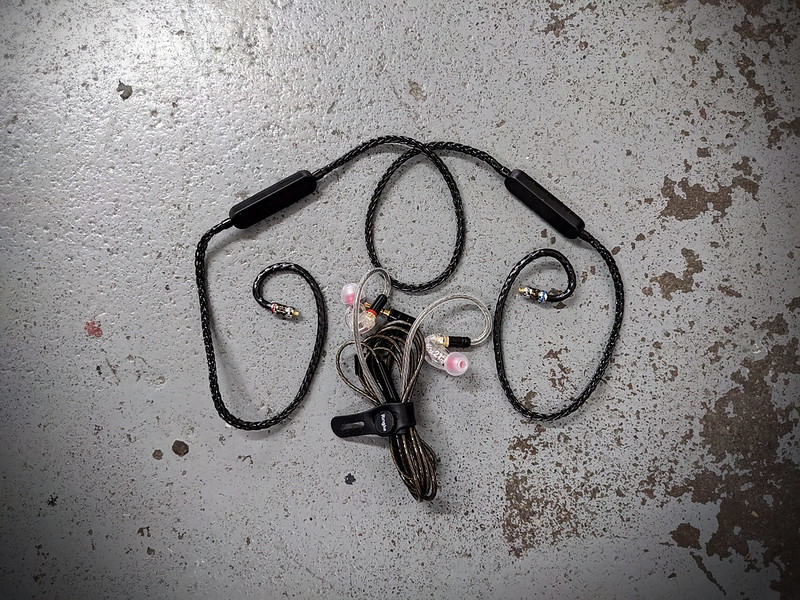Loop Switch
I’ve been carrying the Loop Switch earplugs everyday for the past 13 months now. A couple months ago, Loop replaced this model with the Switch 2. This v2 Switch looks to be a minor incremental upgrade, but overall the same product. I think my impressions of the v1 Switch are still relevant.
The Switch is an earplug with a rotary mechanism that allows the attenuation to be adjusted between three different modes:
- Quiet (v1: 25 dB SNR, v2: 26 dB SNR)
- Experience (v1: 21 dB SNR, v2: 23 dB SNR)
- Engage (v1: 17 dB SNR, v2: 20 dB SNR)
My most frequent application for earplugs is nightclubbing. Having three modes on a single pair of plugs, which can be adjusted in-ear, is a really great capability in this application. If I happen to find myself near a speaker, I can crank them up to Quiet. Then when I join the cool kids in the back, I dial them down to Engage and can carry on a conversation with someone while still being protected. At shows with multiple artists I often find myself setting them to Experience for an opener, going down to Engage between sets, and then up to Quiet for the headliner.
I have not found any other earplug that offers anything quite like this. There are others that have multiple filters that you can swap between, but the earplugs need to be removed from your ear to do that. And even then, trying to mess around with taking out one small part and install another, in the dark, in the middle of Club Hel, is not a winning strategy.
Previously, my preferred plugs were the SureFire EP3 Sonic Defenders. These are in a somewhat similar vein as the Loop Switch, in that they have filter caps that can be opened or closed to adjust the attenuation. I find the Switch to be superior. The Sonic Defenders offer 24 dB SNR when the caps are closed, which is good, but only 11 dB SNR when the caps are open. This isn’t much, so I find that my for use cases the Sonic Defenders only really get used in cap-closed mode. The range of attenuation offered by the Switch (both v1 and v2) is a more useful neighborhood for the environments I operate in.
The mechanical nature of the Switch means that the body itself is a rigid plastic. This makes them inappropriate for sleeping. At least, if you spend any time on your side. They don’t stick out much, but they do so enough that sleeping on them is uncomfortable. I bought a pair of Loop Quiet 2 earplugs this summer for sleeping. These are entirely made of a soft silicone, and I find them comfortable to wear all night. I do not sleep with earplugs regularly, but anytime I’m on the road I throw the Quiets in my bag (along with the Switch – they’re small enough that I’m fine with carrying both sets) in case the hotel or campsite or redoubt or whatever is loud.
I’ve worn the Switch for multiple consecutive hours, and find them to be perfectly comfortable (as long as you are not laying on them). With other plugs it’s often a relief to finally remove them, not because they cause any discomfort when installed, but just because they feel like they’ve been cutting me off from the world for a few hours. Removing them is like coming up for a breath of air – a breathe the free air again my friend sort of moment. Not so with the Switch, I think because I am periodically dropping them down to Engage mode when appropriate. Sometimes I forget to take them out for a while after leaving.
The Switch comes with four different sizes of silicone tips to adjust the fit. Replacement tips are available to extend the life of the tool.
The dial of the Switch has a small tab protruding. This provides a haptic reference point for what mode is selected, and gives you something to grab on to when moving the dial. It works well enough for switching the dial between Quiet and Experience modes. But Engage mode is the most anterior position on the dial, and when in that mode I find the tab slips underneath my tragus. It is small enough that this causes no discomfort, but the smallness also means it can be difficult to get purchase on the tab to pull the dial back to either of the other two modes. I have to slip a fingernail under there to grab it, which sometimes takes a couple seconds to get right. This is the only negative thing I have to say about the Switch, and I am told this was fixed on the Switch 2. It is not enough of an annoyance to make me want to move to new model while my current ones are still working fine, but I look forward to someday upgrading.
All of the earplugs offered by Loop feel a little overpriced, but the two models I have are good products, and I think it’s great that they are trying to normalize PPE into a fashion accessory. I want more of that in the world.






